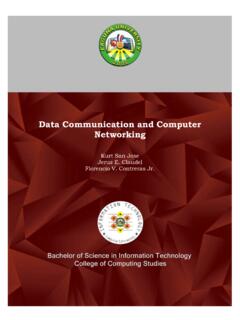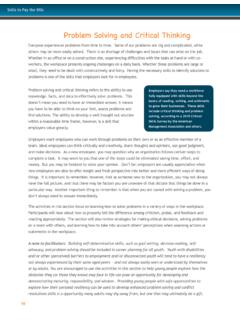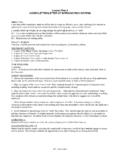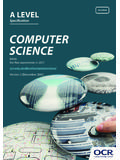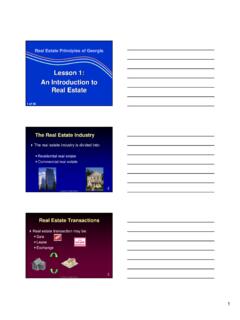Transcription of COMPUTER NETWORKS AND DATA COMMUNICATION
1 ManagementMEDIAHEALTHlawDESIGNEDUCATIONM USIC agricultureLANGUAGEMECHANICS psychologyBIOTECHNOLOGYGEOGRAPHYARTPHYSI CS historyECOLOGYCHEMISTRY mathematicsENGINEERINGCOMPUTER NETWORKS AND data COMMUNICATION Subject: COMPUTER NETWORKS AND data COMMUNICATION Credits: 4 SYLLABUS data Communications Fundamentals COMMUNICATION model, COMPUTER communications architecture, OSI model, TCP/IP, standards, signals, analog and digital transmission, transmission media, line configuration, topologies, data communications codes, error detection and correction methods. data Modem & Modulation data encoding methods, analog to digital, digital to analog etc., data modulation methods: ASK, FSK, PSK, QAM, M-ary systems. data modems: modulation interface, operation on 2 wire, 4 wire and dial up lines. data Communications Methods data COMMUNICATION interface, line control unit, UART, USRT, Serial interface, terminal types.
2 data Link Control & Multiplexing Flow control, error detection & control, IBM Bisync protocol, SDLC, HDLC, HDLC line procedures, time division multiplexing (TDM), FDM, line encoding, carriers. data COMMUNICATION Networking Switched NETWORKS , circuit switching, packet switching, broadcast NETWORKS , LAN, WAN topologies, ATM & Frame relay, cell relay. Suggested Readings: 1. data Communications and Networking, Fourth Edition by Behrouza A. Forouzan,TMH 2. COMPUTER NETWORKS , ,4th edition,Pearson education 3. Introduction to data communications and Networking, ,Pearson education 4. data and COMPUTER Communications, and ,CRC Press,Taylor and Francis Group 5. An Engineering Approach to COMPUTER ,2nd Edition,Pearson Education 6. Understanding communications and NETWORKS ,3rd Edition, ,Cengage Learning iCOMPUTER NETWORKS AND data COMMUNICATIONCOMPUTER NETWORKS AND data COMMUNICATIONThis course presents an overview of data communications andcomputer NETWORKS , including network hardware and networksoftware, as well as reference models, example NETWORKS ,example data COMMUNICATION services and network standardiza-tion.
3 The ISO and the Internet (TCP/IP) COMPUTER networkmodels are discussed in details. The course covers each networklayer in details, starting from the Physical layer to the Applica-tion layer. It also includes an overview of network securitytopics. The physical network layer covers a guided and wirelesstransmission media, the telephone system, and Internet accessnetworks, such as DSL, ISDN and Cable modem. It alsopresents and overview of ATM NETWORKS . The data Link Layercovers design issues, error detection and correction, elementarydata link protocols, sliding window protocols and example datalink protocols. The Medium Access Sub-layer covers thefollowing subjects: the channel allocation problem, multipleaccess protocols, IEEE standard 802 for LAN s and MAN s,bridges, high-speed and wireless LAN s. However, withphenomenal advances in fields like Local Area NETWORKS (LANs), client/server architecture and the advent of high speedtechnologies such as ADSL, Frame Relay and ATM, thenetwork has become inseparable from the computers it functions of the network Layer are explained in context ofdesign issues, routing algorithms, congestion control andinternetworking.
4 The IPv4 and IPv6 protocols are covered inCOURSE OVERVIEW detail. The Transport Layer includes the transport service,elements of transport protocols, and a detailed presentation ofTCP and UDP internet transport protocols. The ApplicationLayer issues cover major Internet applications, such as, DNS(Domain Name System), Electronic Mail, FTP and the WorldWide Web. It also includes an introduction to the main networksecurity is now feasible to connect the best of desktops, minis andmainframes, and to bring them in a common orbit with theobjective of enhancing organizational productivity. Thedramatic improvement in microprocessor power per dollar andthe pressure towards globalization are also accelerating the trendtowards distributed and desktop oriented computing. Theongoing construction of the digital Information Superhighway,the escalating importance of the Internet, the rush to buildsecure and reliable Internet applications for electronic commerce,and the emergence of new computing paradigms such asnetwork computing have created a new vista of opportunitiesand challenges for Information Technology (IT) NETWORKS AND data No.
5 data COMMUNICATION FundamentalsLesson 11 lesson 23 lesson 36 lesson 48 lesson 510 lesson 6 Line Configuration, Topologies12 data Modem & ModulationLesson 714 lesson 815 lesson 916 lesson 1018 data Communications MethodsLesson 1119 data Link Control & MultiplexingLesson 1220 lesson 1323 lesson 1425 lesson 1526 lesson 1628 lesson 1730 lesson 1832 lesson 1934 lesson 2036 CONTENTCOMPUTER NETWORKS AND data COMMUNICATIONivCOMPUTER NETWORKS AND data No. data COMMUNICATION Networking lesson 2138 lesson 2240 lesson 2342 lesson 2443 lesson 2545 lesson 2647 CONTENTCOMPUTER NETWORKS AND data COMMUNICATION1 COMPUTER NETWORKS AND data COMMUNICATIONUNIT IDATA COMMUNICATION FUNDAMENTALST oday s Topics COMMUNICATION and data COMMUNICATION A transmission system The basic data COMMUNICATION modelObjectivesUpon completion of this lesson , you should be able to: Explain how data COMMUNICATION happens Explain the basic data COMMUNICATION COMMUNICATION What is COMMUNICATION ?
6 You are right! It is just exchange of information between COMMUNICATION is similarly exchange of informationbetween two will first see a basic data COMMUNICATION model before weproceed any Basic COMMUNICATION ModelCommunication defined more technically can be described asthe conveyance of a message from one entity, called the sourceor transmitter, to another, called the destination or receiver,via a channel of some very basic example of such a COMMUNICATION system isconversation; people commonly exchange verbal messages, withthe channel consisting of waves of compressed air molecules atfrequencies, which are audible to the human ear. This is depictedin Figure conveyance of a message could be followed by a reciprocalresponse message from the original destination (now a source)to the original source (now a destination) to complete one cyclein a dialogue between corresponding entities. Depending on theapplication or need for the information exchange, either atomicone-way transactions or a two-way dialogue could be : Basic COMMUNICATION ModelLESSON 1 Now how do you make out that the message has correctlyreached the destination?
7 In our example of conversation between two people- thereceiver would usually acknowledges the receipt of the messageeither by nodding his head or with some reply like Iunderstand . This acknowledged form of dialogue is the basisof reliable COMMUNICATION - somehow the source must getfeedback that the destination correctly received the basic model explained above wherein originator anddestination are human beings can be generalized as in To suit the data COMMUNICATION between two systemsexchanging information between data CommunicationSo in data COMMUNICATION who is the sender and the receiver?Let us try to understand this along with a few SourceDevice that generates the data to be passed on to theDestination device. It could be a user COMPUTER trying to makea query to a server TransmitterIf the data generated by the Source device has to be transmittedthrough Transmission Channel or Transmission Systemthen it has to be presented in a form that is acceptable to theTransmission system.
8 This job is done by the Transmitter. Forexample, a modem takes a digital bit stream from the attachedcomputer and transforms that stream of bits into an analogsignals which can be handled by the telephone that you know that at the sending end the data isconverted to a form suitable for transmission, naturally whatshould be done at the receiving end? ReceiverThis receives the signal from the transmission system andconverts it into a form that is suitable to the destination example, a modem accepts analog signal from atransmission channel and transforms it into digital bit DestinationDevice to which the source device sends Transmission SystemWhat is the role of the transmission system?This can be a single transmission line connecting the twosystems communicating or a complex network to whichnumerous communicating systems are NETWORKS AND data COMMUNICATIONF igure Simple data COMMUNICATION data COMMUNICATION ModelFigure provides a new perspective on the datacommunication model of Let us trace through thedetails of this figure using electronic mail as an data COMMUNICATION model Consider that the source input device and transmitter arecomponents of a personal COMPUTER .
9 The user of the PCwishes to send a message to another user for example, Havea nice day (m). The user activates the electronic mail package onthe PC and enters the message via the keyboard. The characterstring is briefly buffered in main memory. We can view it as asequence of bits (g) in memory. The personal COMPUTER isconnected to some transmission medium, such as a localnetwork or a telephone line by an I/O device (transmitter), suchas a local network transceiver or a modem. The input data aretransferred to the transmitter as a sequence of voltage shifts g(t)representing bits on some communications bus or cable. Thetransmitter is connected directly to the medium and convertsthe incoming stream [g(t)] into a signal [s(t)] suitable fortransmission. The transmitted signal s(t) presented to themedium is subject to a number of impairments, before itreaches the receiver. Thus, the received signal r(t) may differ tosome degree from s(t).
10 The receiver will attempt to estimate theoriginal s(t), based on r(t) and its knowledge of the medium,producing a sequence of bits g (t). These bits are sent to theoutput personal COMPUTER , where they are briefly buffered inmemory as a block of bits (g ). In many cases, the destinationsystem will attempt to determine if an error has occurred and, ifso, will cooperate with the source system to eventually obtain acomplete, error-free block of data . These data are then presentedto the user via an output device, such as a printer or a message (m ), as viewed by the user, will usually be an exactcopy of the original message (m).Now consider a telephone conversation. In this case, the inputto the telephone is a message (m) in the form of sound sound waves are converted by the telephone into electricalsignals of the same frequency. These signals are transmittedwithout modification over the telephone line.

![Public Policy [Rai Foundation] - NIILM University](/cache/preview/8/c/5/8/0/4/d/9/thumb-8c5804d92afc80c17eb7fbb21b333501.jpg)
